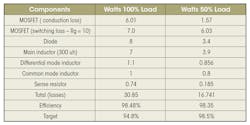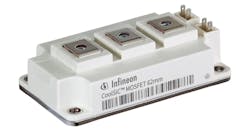Download this article as a .PDF
Advances in wide bandgap (WBG) power devices are enabling silicon-carbide (SiC) and gallium-nitride (GaN) devices that can operate at higher voltages and temperatures than conventional semiconductor devices. Also, they can switch at faster speeds with lower switching losses. New SiC and GaN solutions and developments are especially taking hold in three fields: data centers, wireless charging, and energy harvesting. Each of these application areas are driving the development of WBG power devices in different ways, resulting in various product evolutions:
Data centers. The overall power consumption for data centers over the period covering 2010 to 2020 is expected to exceed 70 billion kW. Datacenter designers are always looking for better solutions to help them improve the efficiency of their designs for energy saving purposes. In response, semiconductor companies like Transphorm Inc., Texas Instruments, and Wolfspeed had developed WBG-based power-supply solutions. An example is a 2kW totem pole PFC topology developed by Wolfspeed for a power supply utilizing SiC MOSFETs capable of reaching 80+ titanium standards in data centers while keeping cost under control.
The totem pole PFC topology chosen by Wolfspeed for this reference design has a low component count with high efficiency because it doesn’t have a bridge rectifier feeding it. With fewer components, it has a high power density and can be operated at relatively high switching frequencies. The design contains a pair of silicon diodes that help to achieve a low cost approach while still reaching the desired efficiency. The design, which contains two 900-V SiC MOSFETs, is claimed to reach a peak efficiency of 98.5% at 50% load at 230V. The breakdown of the losses with the estimated efficiency at 230V is as follows:
Wireless charging. GaN allow designers to use wireless charging in a wider range of products without having to redesign the antennas. Energous, the developer of WattUp, just announced a new GaN based, high-power Near Field WattUp transmitter reference design. It is capable of charging devices with up to 10 watts of energy. In doing so, it increases the amount of power delivered to receiving devices, while also eliminating connectors and charging contacts for a much wider variety of devices. The solution includes a GaN-based 5-10W RF receiver IC and a GaN-based 10-15W RF power amplifier (PA).
“These first GaN-based solutions for our WattUp wire-free charging technology support higher power and improved charging flexibility,” said Michael Leabman, founder & CTO of Energous. “Our ability to develop multiple components within the WattUp ecosystem allows us to innovate based on our customer needs.”
Another company leveraging GaN technology is Solace Power. It uses a technology called Resonant Capacitive Coupling (RC2). In fact, the firm has developed a demo that uses capacitive resonance to deliver power to flying drones (Fig. 1) that can be charged several inches above the charging pad on moving automobiles, increasing total time in the air and reducing human interaction. The demo uses EPC’s GaN FETs working at 13.56 MHz. Compared to silicon devices that can handle the same power levels, these FETs are five to 10 times smaller.
Energy harvesting. The energy and semiconductor sectors are also aware of the many benefits of GaN and SiC, along with the growth opportunities to maximize solar harvesting technology with better switching loss performance. Infineon, for example, has expanded its portfolio of SiC power module solutions by developing additional module platforms and topologies for the 1200 V CoolSiC MOSFET family, including a full-SiC module and two half-bridge topology modules (Fig. 2).
Due to extended robustness, Infineon is taking advantages of the lower failure in time (FIT) and short-circuit capability. Initially, this product will support applications such as photovoltaic inverters, battery charging, and charging/storage systems.
GaN and SiC devices are already being adopted in these and other markets. Yet we will see a bigger shift from silicon wafers to WBG substrates in the future, thanks to research and development. For example, The U.S. Department of Energy (DOE) advanced $32 million in funding for 16 projects as part of two new Advanced Research Projects Agency-Energy (ARPA-E) programs: ENergy-efficient Light-wave Integrated Technology Enabling Networks that Enhance Datacenters (ENLITENED) and Power Nitride Doping Innovation Offers Devices Enabling SWITCHES (PNDIODES).
With $25 Million, the ENLITENED program will seek to double datacenter energy efficiency by deploying new network designs enabled by integrated photonics technologies. Similarly, the ARPA-E’s PNDIODES program will take its approximate $6.9 million to develop transformational advances in the process of selective area doping in the wide-bandgap (WBG) semiconductor, gallium nitride (GaN), and its alloys.
About the Author
Maria Guerra
Power/Analog Editor
Maria Guerra is the Power/Analog Editor for Electronic Design. She is an Electrical Engineer with an MSEE from NYU Tandon School of Engineering. She has a very solid engineering background and extensive experience with technical documentation and writing. Before joining Electronic Design, she was an Electrical Engineer for Kellogg, Brown & Root Ltd (London. U.K.). During her years in the Oil and Gas Industry she was involved in a range of projects for both offshore and onshore designs. Her technical and soft skills bring a practical, hands-on approach to the Electronic Design team.




